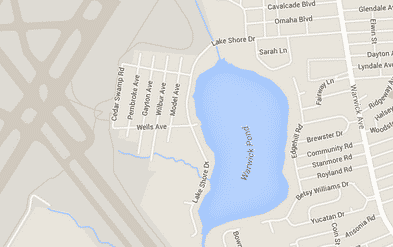
[wpgmappity id=”44″]
Warwick, RI – Stay clear of swimming in, fishing from or other contact with Warwick Pond — the RI Department of Environmental Management warns there’s a blue-green algae bloom in the body of water making the water toxic.
The RIDEM notes their warning about the bloom, caused by high levels of toxic cyanobacteria, is likely to remain in effect through Nov. 1. The agency also warns other areas of the state may be affected by similar blooms, marked by water that resembles green paint or thick pea soup.
People should avoid drinking water or eating fish from the pond, the RIDEM reported in a release posted to their website Wednesday. Pets can also be affected by exposure to the algal toxins and thus owners should not allow pets to drink this water or swim in the water.
Irritation of the skin, nose, eyes, and or throat are common side effects that result from skin contact with water containing algal toxins. If people drink such contaminated water, health effects could include stomach ache, diarrhea, vomiting, and nausea.
Young children and pets are more at-risk to algal toxins than adults, since they are more likely to drink contaminated water. Other health effects, which are rarer, include dizziness, headache, fever, liver damage, and nervous system damage. People who have been swimming in or otherwise in contact with Warwick Pond and experience those symptoms should contact their healthcare provider, the release reports.
If you come into contact with the water, rinse your skin with clean water as soon as possible, and when you get home, take a shower and wash your clothes. Similarly, if your pet comes in contact with the water, immediately wash your pet off with clean water. Do not let the animal lick algae off of its fur.
Call a veterinarian if your animal shows any symptoms of blue-green algae poisoning, which include loss of energy, loss of appetite, vomiting, diarrhea, or any unexplained sickness that occurs within a day or so after being in contact with water. People are cautioned that toxins may persist in the water after the blue-green algae bloom is no longer visible.
It is possible that blue-green algae blooms may be affecting other areas of Rhode Island, the DEM reports. People are advised to avoid contact with waters that exhibit the following conditions: bright green coloration in the water or at the water surface and/or dense floating algal mats that form on the water’s surface.
The water may look like green paint, thick pea soup, or green cottage cheese.
To report suspected blue-green algae blooms, contact Brian Zalewsky in DEM’s Office of Water Resources at 222-4700 ext. 7145 or by e-mail at brian.zalewsky@dem.ri.gov and if possible, send a photograph of the reported algae bloom.
This is a test
